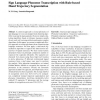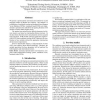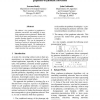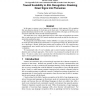VLSISP
2010
13 years 9 months ago
2010
A common approach to extract phonemes of sign language is to use an unsupervised clustering algorithm to group the sign segments. However, simple clustering algorithms based on dis...
INTERSPEECH
2010
13 years 10 months ago
2010
We present a pronunciation error detection method for second language learners of English (L2 learners). The method is a combination of confidence scoring and landmark-based Suppo...
NAACL
2010
14 years 1 months ago
2010
We address a key problem in grapheme-tophoneme conversion: the ambiguity in mapping grapheme units to phonemes. Rather than using single letters and phonemes as units, we propose ...
INFORMATICALT
2007
14 years 3 months ago
2007
This paper describes a framework for making up a set of syllables and phonemes that subsequently is used in the creation of acoustic models for continuous speech recognition of Lit...
INFORMATICALT
2008
14 years 3 months ago
2008
Abstract. The present work is concerned with speech recognition using a small or medium size vocabulary. The possibility to use the English speech recognizer for the recognition of...
LREC
2010
14 years 4 months ago
2010
This paper presents the outline and performance of an automatic syllable boundary detection system. The syllabification of phonemes is performed with a rule-based system, implemen...
GW
1999
Springer
14 years 7 months ago
1999
Springer
In this paper we present a novel approach to continuous, whole-sentence ASL recognition that uses phonemes instead of whole signs as the basic units. Our approach is based on a se...
FGR
2002
IEEE
14 years 8 months ago
2002
IEEE
Hitherto, the major challenge to sign language recognition is how to develop approaches that scale well with increasing vocabulary size. In this paper we present an approach to la...
ICMCS
2007
IEEE
14 years 9 months ago
2007
IEEE
We introduce a novel and inexpensive approach for the temporal alignment of speech to highly imperfect transcripts from automatic speech recognition (ASR). Transcripts are generat...




